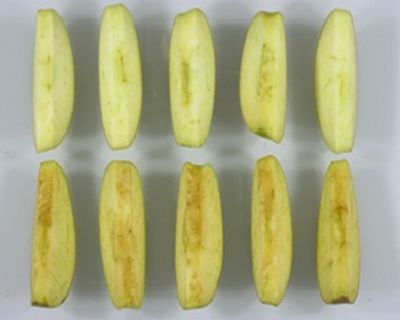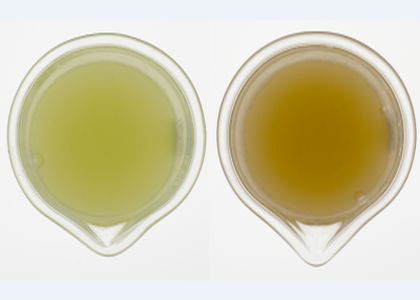Guest Blog: Nonbrowning Arctic Apples & Their Applications
When it comes to the foods available in a typical North American grocery store, the reality is few of today’s products are the same as they were decades ago thanks to human innovation. The history of agriculture is one of frequent, deliberate improvements to the crops we grow, and nonbrowning apples are just the latest example of this.
March 26, 2015


Editor’s Note: In February, USDA’s Animal and Plant Health Inspection Service (APHIS) announced its decision to deregulate two apple varieties engineered to resist browning: Arctic Golden and Arctic Granny apples. APHIS found the “apples are unlikely to pose a plant pest risk to agriculture and other plants in the United States." The following guest blog is from Neal Carter, P.Eng., president and founder of Okanagan Specialty Fruits (OSF), the agriculture biotechnology company that created the nonbrowning Arctic apple.
When it comes to the foods available in a typical North American grocery store, the reality is few of today’s products are the same as they were decades ago thanks to human innovation. The history of agriculture is one of frequent, deliberate improvements to the crops we grow, and nonbrowning Arctic® apples are just the latest example of this.
Our company’s apples have drawn a great deal of attention over the past few weeks because of the manner by which they were developed—biotechnology. Advances in agricultural biotechnology have allowed precise enhancements to our food in a way that has not been possible with conventional breeding. In the case of Arctic apples, we simply silenced the specific genes that initiate enzymatic browning, and did so while maintaining the apples’ nutritional value and adding no novel proteins into the fruit.
There is a great deal of misinformation about the highly technical subject of biotechnology, and because of this, public and regulatory scrutiny of biotech crops is very high, but there is a silver lining to all of this analysis. Everyone should feel safe knowing that approved biotech crops are among the most tested foods on the planet. Arctic apples, for instance, were planted in field trials for well over a decade before receiving U.S. approval.
With the level of scrutiny required to bring a new product like this to fruition, some may wonder why bother going through so much trouble to develop a nonbrowning apple? Apples are already among the most popular fruits on the planet, so the fact that they brown shouldn’t be too important of an issue, right? Not really. We know there is tremendous opportunity to make the perfect fruit even better with this one precise improvement.
Apple consumption in North America has been flat-to-declining for the last few decades, while obesity rates have skyrocketed. Consumers are snacking more than ever before and eating more meals outside the home in general. The importance of convenient, snack foods has never been higher. The simple convenience of baby carrots doubled carrot consumption when they were introduced, yet the availability of fresh-cut apple products in places like cafeterias and restaurants is currently held back by the browning issue.
At a time when healthy foods are poised to play a bigger role in nutrition, nonbrowning apples can help get more apples into more places. Nonbrowning apples eliminate the need for anti-browning treatments, which are responsible for up to 40-percent of processing costs and can impart an off-taste. Fresh-cut apples currently make up approximately 3 percent of apple sales, but nonbrowning apples significantly can boost this number while providing consumers with a higher quality eating experience.

Other potential applications for nonbrowning apples are diverse and intriguing. For example, Arctic® Granny juice better retains its original taste and bright-green color, meaning nonbrowning apples have excellent suitability for unique, variety-specific juices (not to mention sauces, fruit leathers or many other novel apple products). Arctic varieties can help apples carve out a well-deserved place in salads, fruit cups and prepackaged products like apple pie kits, to name just a few areas where the nonbrowning trait can be a difference-maker.

A recent study from Cornell University showed that when apples are served to students sliced, rather than whole, consumption increases about 70 percent. The study also found that the percentage of students who ate at least half of their apple increased by 73 percent when fruit was served sliced rather than whole, which meant more apples got eaten rather than wasted.
This is no small point because apples are among the most wasted foods on the planet; about 40 percent of what’s produced gets thrown into the trash. If just serving apples pre-sliced can reduce waste, imagine the impact of apples that, not only don’t brown when sliced, they also don’t show superficial bruises that cause picky eaters to turn up their noses.
So in the end, it’s an extremely tough road to develop and obtain approval for a biotech-enhanced product, but we know the science supports their safety, and the potential payoff for apple producers and consumers alike is well worth the effort.
Neal Carter is president and founder of Okanagan Specialty Fruits (OSF), an agriculture biotechnology company based in British Columbia specializing in the creation of novel tree fruit varieties. He has worked as a bioresource engineer for more than 30 years with numerous crops, ranging from maize to mango, from growing to harvesting, packing, storage, processing and packaging. He can be contacted at [email protected].
You May Also Like